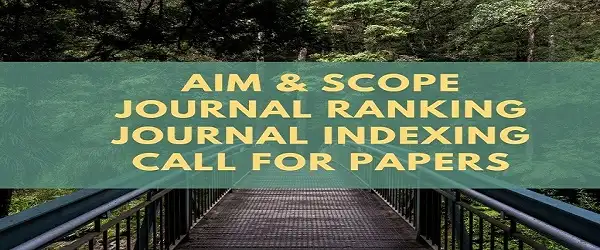Human Ecology Review impact factor, indexing, ranking (2024)

Aim and Scope
The Human Ecology Review is a research journal that publishes research related to Environmental Science; Social Sciences. This journal is published by the Society for Human Ecology. The ISSN of this journal is 10744827. Based on the Scopus data, the SCImago Journal Rank (SJR) of human ecology review is 0.285.
Also, please check the following important details about human ecology review: Publisher, ISSN, Ranking, Indexing, Impact Factor (if applicable), Publication fee (APC), Review Time, and Acceptance Rate.
According to Clarivate's JCR, journals indexed in SCIE/SSCI have an impact factor.
Human Ecology Review Ranking
The Impact Factor of Human Ecology Review is 0.545.
The impact factor (IF) is a measure of the frequency with which the average article in a journal has been cited in a particular year. It is used to measure the importance or rank of a journal by calculating the times its articles are cited.
The impact factor was devised by Eugene Garfield, the founder of the Institute for Scientific Information (ISI) in Philadelphia. Impact factors began to be calculated yearly starting from 1975 for journals listed in the Journal Citation Reports (JCR). ISI was acquired by Thomson Scientific & Healthcare in 1992, and became known as Thomson ISI. In 2018, Thomson-Reuters spun off and sold ISI to Onex Corporation and Baring Private Equity Asia. They founded a new corporation, Clarivate, which is now the publisher of the JCR.
Important Metrics
| Journal Title: | Human Ecology Review |
| Publisher: | Society for Human Ecology |
| ISSN: | 10744827 |
| Type: | journal |
| Journal Scope: | Environmental Science; Social Sciences |
| Country: | United States |
| H-Index: | 45 |
| SJR: | 0.285 |
| Quartile: | Geography, Planning and Development (Q3); Management, Monitoring, Policy and Law (Q3) |
human ecology review Indexing
The human ecology review is indexed in:
An indexed journal means that the journal has gone through and passed a review process of certain requirements done by a journal indexer.
The Web of Science Core Collection includes the Science Citation Index Expanded (SCIE), Social Sciences Citation Index (SSCI), Arts & Humanities Citation Index (AHCI), and Emerging Sources Citation Index (ESCI).
Human Ecology Review Impact Factor 2024
The latest impact factor of human ecology review is 0.545.
The impact factor (IF) is a measure of the frequency with which the average article in a journal has been cited in a particular year. It is used to measure the importance or rank of a journal by calculating the times it's articles are cited.
Note: Every year, The Clarivate releases the Journal Citation Report (JCR). The JCR provides information about academic journals including impact factor. The latest JCR was released in June, 2023. The JCR 2024 will be released in the June 2024.
Human Ecology Review Quartile
The latest Quartile of human ecology review is Q3.
Each subject category of journals is divided into four quartiles: Q1, Q2, Q3, Q4. Q1 is occupied by the top 25% of journals in the list; Q2 is occupied by journals in the 25 to 50% group; Q3 is occupied by journals in the 50 to 75% group and Q4 is occupied by journals in the 75 to 100% group.
Publication fee
Based on the Official Journal Homepage, the human ecology review does not charge any publication fee.
An article processing charge (APC), also known as a publication fee, is a fee which is sometimes charged to authors. Most commonly, it is involved in making a work available as open access (OA), in either a full OA journal or in a hybrid journal.
Call for Papers
Visit to the official website of the journal/ conference to check the details about call for papers.
How to publish in Human Ecology Review?
If your research is related to Environmental Science; Social Sciences, then visit the official website of human ecology review and send your manuscript.
Tips for publishing in Human Ecology Review:
- Selection of research problem.
- Presenting a solution.
- Designing the paper.
- Make your manuscript publication worthy.
- Write an effective results section.
- Mind your references.
Acceptance Rate
Acceptance rate is the ratio of the number of articles submitted to the number of articles published. Researchers can check the acceptance rate on the journal website. Alternatively, they can contact the editor of the journal.Journal Publication Time
The Journal Publication Time means the average number of weeks between article submission and publication. According to the journal website, the human ecology review publishes research articles in 26 weeks on an average.
Final Summary
- The impact factor of human ecology review is 0.545.
- The human ecology review is a reputed research journal.
- It is published by Society for Human Ecology.
- The journal is indexed in UGC CARE, Scopus, SSCI, DOAJ.
- It is an open access journal.
- The (SJR) SCImago Journal Rank is 0.285.
- The publication time (Average number of weeks between article submission and publication) of the journal is 26 weeks.
- Based on the Official Journal Homepage, the human ecology review does not charge any publication fee.
Sources: https://press.anu.edu.au/publications/journals/human-ecology-review
SIMILIAR JOURNALS
INTERNATIONAL JOURNAL OF TRANSGENDER HEALTH
ISSN: 2689-5269Publisher: TAYLOR & FRANCIS INC
ISSN: 1049-7323
Publisher: SAGE PUBLICATIONS INC
JOURNAL OF HEALTH AND SOCIAL BEHAVIOR
ISSN: 0022-1465Publisher: SAGE PUBLICATIONS INC
ISSN: 2590-0617
Publisher: ELSEVIER
ISSN: 2666-7894
Publisher: ELSEVIER
ISSN: 2050-1242
Publisher: CAMBRIDGE UNIV PRESS
HISTORICAL SOCIAL RESEARCH-HISTORISCHE SOZIALFORSCHUNG
ISSN: 0172-6404Publisher: GESIS LEIBNIZ INST SOCIAL SCIENCES
ISSN: 1463-6778
Publisher: ROUTLEDGE JOURNALS, TAYLOR & FRANCIS LTD
INTERNATIONAL JOURNAL OF POPULATION DATA SCIENCE (IJPDS)
ISSN:Publisher: SWANSEA UNIV
ENVIRONMENTAL GEOCHEMISTRY AND HEALTH
ISSN: 0269-4042Publisher: SPRINGER
TOP RESEARCH JOURNALS
- Agricultural & Biological Sciences
- Arts & Humanities
- Business, Management and Accounting
- Chemistry
- Computer Science
- Education
- Engineering
- Mathematics
- Medicine
- Physics
- Social Sciences